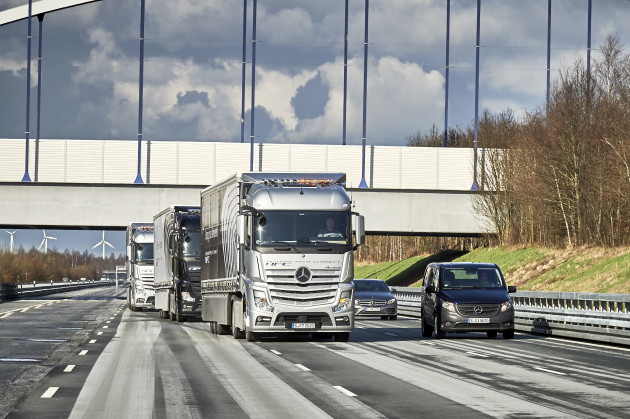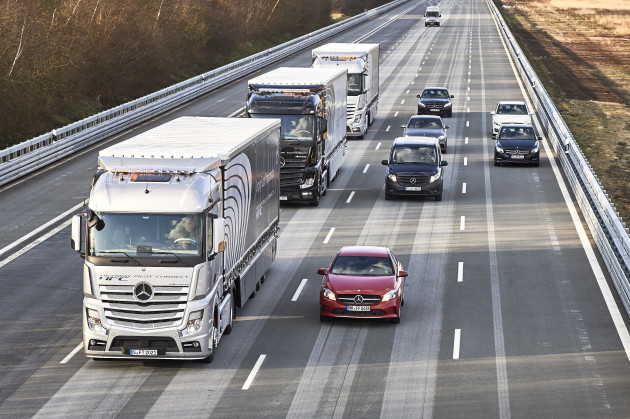Daimler demonstrates autonomously driven truck platoon
DUSSELDORF, Germany — In what was the first demonstration of its kind, Daimler today showcased a truck platoon featuring three autonomously driven Mercedes-Benz trucks.
The demonstration was held on Autobahn A52 just outside Dusseldorf, and was part of a major global event held by Daimler Trucks that included more than 300 media from 36 countries. The theme of the event was connectivity and it built upon the company’s Shaping Future Transportation mantra, which it established two years ago with the introduction of the Highway Pilot autonomous truck platform.
This year, Daimler is showcasing Highway Pilot Connect, which not only allows autonomous operation of the trucks but also allows them to connect through vehicle-to-vehicle communications in a platoon formation to save fuel. Tests have shown an aggregate fuel savings of 7% for the trucks in the platoon, ranging from 2% for the lead truck to 11% for the next and 9% for the trailing truck in a three-truck formation. Initiating the platoon was simple. The driver in the lead truck pushed a Highway Pilot Connect button on the dash, which sent the signal to nearby vehicles that it’s ready to form the platoon.
Following drivers with Highway Pilot Connect do the same and then fall into place. The trucks close to within 15 metres of each other and Highway Pilot takes control of acceleration, braking and steering. If a car gets in between the trucks, as was demonstrated, the following truck backs off and then re-establishes its following distance when the car leaves the lane.

Daimler officials explained that the system can react faster than humans.
At 80 km/h, a human driver would take 1.4 seconds to react to an emergency situation and would cover 30 metres before applying the brakes. Highway Pilot can react within 0.1 seconds and initiate stopping within 2.2 metres, according to Sven Ennerst, head of truck product engineering and global procurement.
In addition to saving fuel, Daimler said platooning makes better use of limited road space. A three-truck platoon takes up just 80 metres instead of the 150 metres that would normally be occupied by three consecutive tractor-trailers. That means the same three trucks require 7% less space.
Drivers must remain at the controls at all times and be prepared to take over when the Highway Pilot system loses sight of the lane markings or when a lane change is required.
“We do platooning for three reasons,” said Dr. Wolfgang Bernhard, head of Daimler Trucks globally. “It makes better use of the infrastructure, it reduces fuel consumption and greenhouse gas emissions and it increases safety.”
It’s not yet clear when North American jurisdictions will allow the system to be brought to North America. Daimler’s Highway Pilot autonomous driving system has already been widely demonstrated in Nevada.
Daimler announced it will be investing $500 million Euros into connectivity by 2020. It says 365,000 of its trucks are already connected via FleetBoard in Europe and Detroit Connect in North America. Trucknews.com will have much more news on Daimler’s connectivity initiatives this week.

Have your say
This is a moderated forum. Comments will no longer be published unless they are accompanied by a first and last name and a verifiable email address. (Today's Trucking will not publish or share the email address.) Profane language and content deemed to be libelous, racist, or threatening in nature will not be published under any circumstances.